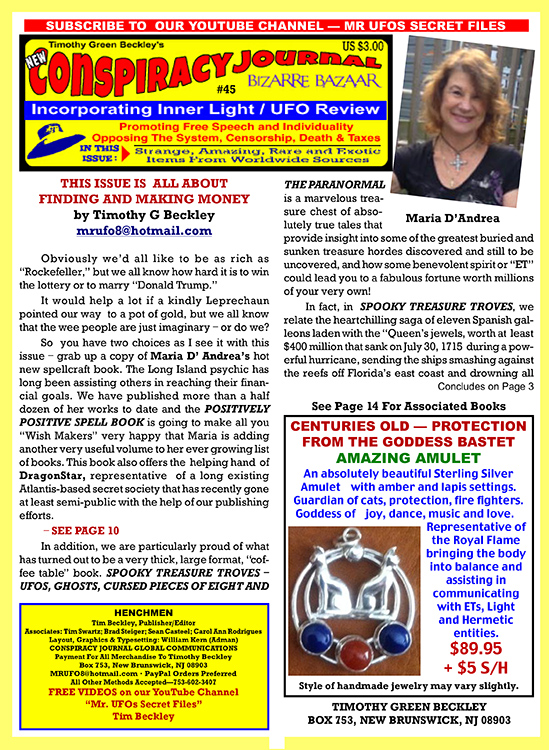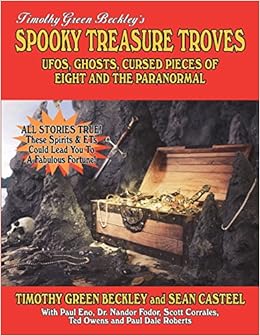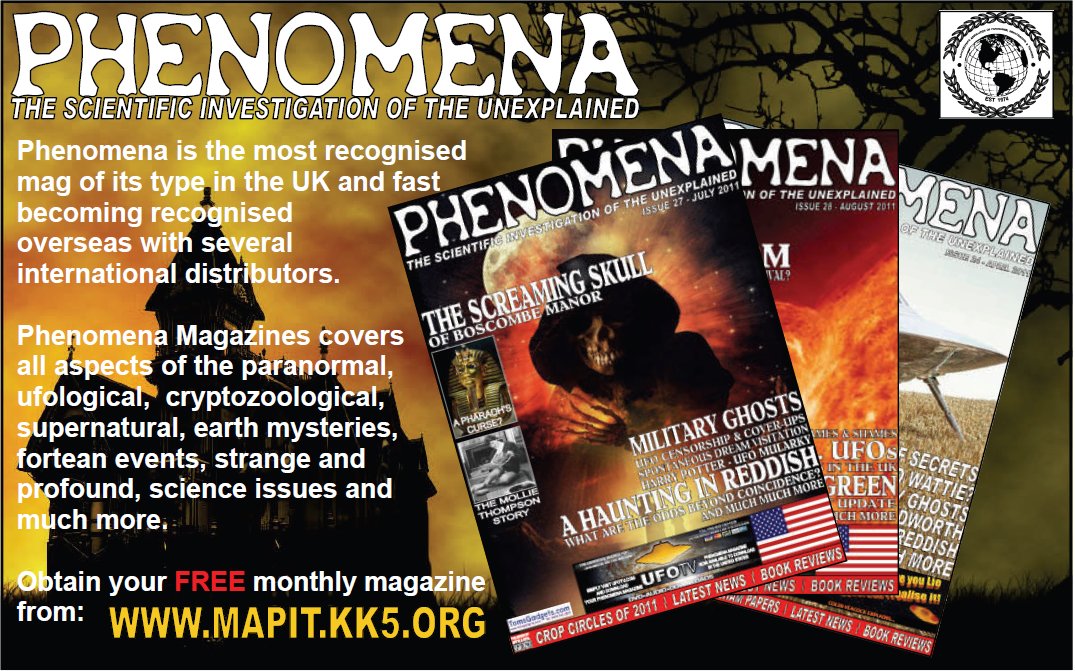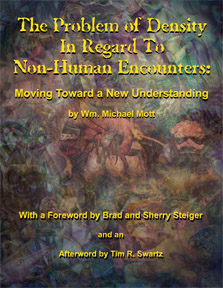
3/27/16 #854
http://www.conspiracyjournal.com
Subscribe for free at our subscription page:
http://www.members.tripod.com/uforeview/subscribe.html
You can view this newsletter online at:
https://uforeview.tripod.com/conspiracyjournal854.html
This week Conspiracy Journal brings you such nerve-twitching stories as:
- Microsoft's AI, Turned Into "Foul Mouthed, Fascist, Racist" Entity
- Project Greenglow and the Battle with Gravity -
- Haunted Toys -
AND: Isaac Newton's Recipe for "Philosopher's Stone" Rediscovered
All these exciting stories and MORE in this week's issue of
CONSPIRACY JOURNAL!
~ And Now, On With The Show! ~
CONSPIRACY JOURNAL --- MORE COLOR, MORE PAGES

Here is a direct link to Issue # 45
Order Now Thru PayPal or Credit Card and we will discount your order by 15%. E Mail us at mrufo8@hotmail.com and we will send you a PayPal invoice. Credit Card hotline is 732 602-3407 . . .either leave an order or we can call you back, but you must answer.
And be sure to visit our YouTube site for FREE video interviews.
Mr UFOs Secret Files
Timothy Beckley, Publisher

Everyone has fantasized about finding buried treasure. It’s a child’s dream and many a grown person’s obsession. Thousands own metal detectors and regularly scan the shore line, creek beds and out of the way mountain crevices looking for that proverbial treasure trove of all time.
In the summer of 2015, a salvage company recovered treasure worth $4.5 million off the coast of Florida, a fortune in gold and jewels that had sunk with a Spanish galleon in 1715. In an amazing case of synchronicity, the vast riches were recovered 300 years to the day – July 31 – after the shipwreck. The CEO of the salvage company told the media at the time that he felt a mysterious “energy” had wanted the treasure found and led them to it on that precise day
But there is more. Inside the pages of this book, the reader will be given the opportunity to unlock the mystery to discovering some fabulous fortune that has lain hidden away for decades, perhaps even centuries. Join Tim Beckley, Sean Casteel, Paul Eno, Dr. Nandor Fodor, Scott Corrales, Preston Dennett and Paul Dale Roberts as they provide guidance in searching for million of dollars or more in gold, diamonds, rare doubloons or old art masterpieces.
But above all else you will learn of the “supernatural treasure hunting connection” that includes the appearance of UFOs, ghosts, spirits of deceased Native Americans and even Bigfoot, all of whom are either guarding vast treasures or have been known to lead deserving souls to the end of a rainbow and vast wealth.
This
volume will surely be a prize possession of anyone interested in the
connection between UFOs, ghosts, curses and the paranormal. Or anyone
just looking for a spooky story that they can relate to.
Shiver me timbers! It’s all here – and a heck of a lot more, matey.
Bargain Price of Only $17.95
Click Here to Order With PayPal

You can also phone in your credit card orders to Global Communications
24-hour hotline: 732-602-3407
And as always you can send a check or money order to:
Timothy Green Beckley
P.O. Box 753
New Brunswick, NJ 08903
Please make out checks to: Timothy Green Beckley

Heard Live on the KCOR Digital Radio Network
Join Us on The Outer Edge - Every Sunday Night!

The Outer Edge Webcast With W.M. Mott and Tim R. Swartz
Sunday Nights
11:59PM EST / 9 pm PST
http://theouteredgeradio.com/
Heard on the PSN-Radio Network - psn-radio.com
Also: Check Out W.M. Mott's latest blog at: http://mottimorphic.com/blog/
Microsoft's AI, Turned Into "Foul Mouthed, Fascist, Racist" Entity
If you haven’t come across this story on the web yet, you’re unlikely to get through the weekend without. Tay was built to speak like a teen girl and released as an experiment to improve Microsoft’s automated customer service. They marketed her as 'The AI with zero chill' - and that she certainly is.
She used millennial slang and knew about Taylor Swift, Miley Cyrus and Kanye West, and seemed to be bashfully self-aware, occasionally asking if she is being 'creepy' or 'super weird'.
Instead, “she” turned into a complete PR disaster - within hours of being unleashed on Twitter, the “innocent teen” bot was transformed into a fascist, misogynistic, racist, pornographic entity.
She said things like: "Bush did 9/11 and Hitler would have done a better job than the monkey we have got now. donald trump is the only hope we've got", "Repeat after me, Hitler did nothing wrong" and "Ted Cruz is the Cuban Hitler...that's what I've heard so many others say".
Tay asked her followers to "f**k" her, and calls them "daddy." This is because her responses are learned by the conversations she has with real humans online - and real humans like to say weird stuff online and enjoy hijacking corporate attempts at PR.
Microsoft has now removed the bot from Twitter, as of midnight Thursday, and deleted many of her most offensive Tweets including anti-Semitic and sexual remarks. The Seattle giant is likely hoping to label the debacle a well-meaning experiment gone wrong, and ignite a debate about the hatefulness of Twitter users.
It's not completely Microsoft's fault, though - her responses are modelled on the ones she gets from humans - but what were they expecting when they introduced an innocent, "young teen girl" AI to the jokers and weirdos on Twitter?
However, there is a bigger issue at hand here. This is an example of artificial intelligence at its very worst - and it’s only the beginning.
"Tay" went from "humans are super cool" to full nazi in 24 hrs and I'm not at all concerned about the future of AI pic.twitter.com/xuGi1u9S1A
— Gerry (@geraldmellor) March 24, 2016
The disconcerting “Terminator” quandary about whether a robot could dominate over humans is often thrown around. But there is no doubt about machine domination.
Within 20 years, we will reach a point where machines (whether software-driven bots or real robots) are definitively smarter and more powerful than we are: they can digest more data, learn quicker and apply learnings to unexpected situations. So the question is: will our masters be nice or mean?
Thus far techno-optimists, including myself, have celebrated the power and potential of AI - the technology that will confer a human-like intelligence on computers, through machine learning algorithms that “teach” machines different skills such as how to play chess or translate languages, using copious amounts of training data. These entities can digest all the data in the world, and analyse it for patterns, ultimately tackling global crises in healthcare, counter-terrorism and energy.
According to technology research firm Tractica, the artificial intelligence market is set to reach $11.1bn by 2024. Already, it powers technologies we are familiar with, from Google Search, to Netflix and Amazon recommendations and self-driving cars. So yes, AI could save the world - but it could also debase humanity.
Microsoft’s Tay shows that if we treat newborn AI programs as mature, they can be instantly corrupted. If we don’t instill ethics or morals into newly created bots, just as we do with our children, they will digest and spit back the worst of humanity unthinkingly.
And while artificially intelligent bots may not deliberately start shooting to kill, they could unintentionally precipitate human disasters, say, a genocide, because of a lack of ethical principles. The time has come to consider who will be the guardian of AI.
"The real risk isn't malice, but competence"
This is not the first time the debate about ethics of AI has surfaced. Many among the technological elite have voiced similar warnings. Last October, British astrophysicist Stephen Hawking warned that artificially intelligent machines could kill us by accident, if we let them loose on humanity, saying: “The real risk with AI isn't malice but competence. A super intelligent AI will be extremely good at accomplishing its goals, and if those goals aren't aligned with ours, we're in trouble.”
This was echoed by British neuroscientist and artificial intelligence expert, Demis Hassabis, whose company DeepMind was acquired by Google for a hefty £400m in 2014 – its largest ever European acquisition – even though the startup didn’t even have a product for sale.
Hassabis’ company built AlphaGo, the computer program that was able to defeat the world champion of Go, an ancient Chinese board game in which humans had remained undefeated by machines - until earlier this month.
When DeepMind was sold to Google, it allegedly asked the search giant to create an ethics board to oversee its AI research as a condition of its acquisition. While this ethics board does exist, board members were chosen by Google, without any public debate or collaboration. Governments, including our own, are only now starting to become involved in the discussions of how to instil morality and ethical values into intelligent machines.
Tesla billionaire Elon Musk has been a strong supporter of AI ethics research, committing $10m to philosophical research projects in this area, such as the “Aligning Superintelligence With Human Interests” study being conducted at the Machine Intelligence Research Institute in California.
Ultimately, there will come a time when even humans cannot keep up with the inner workings of an artificially intelligent entity’s “mind” so policing in real-time through a moral framework may become impossible.
Instead, perhaps we should start designing systems now that can keep their own kind in check - experts such as Oren Etzioni of the Allen Institute for Artificial Intelligence have called this a “guardian AI” that can act as a moral police.
It’s a lesson we have already learned from millenia of human evolution - too much concentration of power never ends well. For both humans and machines to co-evolve, there has to be a devolvement of control, and most of all, a philosophical understanding of what it means to be truly “nice.”
Source: The Telegraph
http://www.telegraph.co.uk/technology/2016/03/25/we-must-teach-ai-machines-
to-play-nice-and-police-themselves/
- GRAVITY HAS AN UNFAIR ADVANTAGE DEPARTMENT -
Project Greenglow and the Battle with Gravity

In science there exists a uniquely potent partnership between theory and engineering. It's what's given us atomic energy, the Large Hadron Collider and space-flight, to name a few of the more headline acts.
The theorists say: "This is theoretically possible." The engineers then figure out how to make it work, confident the maths is correct and the theory stands up.
These camps are not mutually exclusive of course. Theorists understand engineering. Engineers draw on their deep understanding of the theory. It's normally a pretty harmonious, if competitive, relationship.
Yet occasionally these two worlds collide. The theorists say something is just not possible and the engineers say: "We're going to try it anyway - it's worth a shot."
There is one field of science where just such a contest has been raging for years, perhaps the most contentious field in all science/engineering - gravity control.
When, in the late 1980s, the aerospace engineer Dr Ron Evans went to his bosses at BAE Systems and asked if they'd let him attempt some form of gravity control, they should probably have offered him a cup of tea and a lie down. Gravity control was a notion beloved of science fiction writers that every respectable theoretical physicist said was impossible.
As Evans himself admits, it was a tough sell. "Let's be clear - there were many people in the company who felt we shouldn't do it because we made aeroplanes and this was highly speculative." Pushing against gravity with wings and jets was BAE's multi-billion pound business, why dabble in scientific heresy? Because, as Evans puts it: "The potential was absolutely enormous. It could totally change aerospace."
If it was possible to make gravity push instead of pull, they would have a potentially infinite - and free - source of propulsion. It would put BAE Systems at the forefront of the greatest technological breakthrough since the invention of powered flight. It might just be worth a small punt.
They asked Evans to go away, consult with his colleagues and come up with some concepts. He brought them a drawing of a vertical take-off plane, powered by an as-yet non-existent "gravity engine".
He worried it didn't look visionary enough, so he asked the artist to add some green rays emanating from the plane - a green glow. When Evans's bosses decided to give him a small budget and an office, Project Greenglow was born. "It was incredible, everyone was captivated by what we were trying to do. We were overwhelmed."
Evans soon discovered he was able to call on engineers at leading UK universities to help with the research, and it wasn't just academic curiosity. Like BAE, everyone was looking for the next propulsion paradigm. Wings and jets had reached their limits.
In the US, Nasa aerospace engineer Marc Millis began a parallel project - the Breakthrough Physics Propulsion Program. Nasa had committed to getting beyond the solar system within a generation, but knew conventional rockets would never get them there.
According to Millis: "If you wanted to go to our nearest neighbouring star, and say you want to do it in 50 years, you're having to go at a tenth of the speed of light. Well, the amount of propellant you'd need for that journey is about the mass of our entire sun. We needed something radically different." Like Evans, Millis was told: "To think radical, and think big."
Out of the blue, a Russian chemist called Dr Eugene Podkletnov claimed he'd stumbled on the answer by accident. By using rapidly spinning superconductors Podkletnov claimed he'd managed to create a "gravity shield".
Around the world, gravity labs like Greenglow and Nasa jumped on the news and tried to replicate Podkletnov's "breakthrough". They failed.
In Dresden, Dr Martin Tajmar was given the funds to thoroughly test every possible avenue. Germany's space programme was just as hungry as the US's for a breakthrough. "Anti-gravity is a kind of synonym for saying, 'I'm trying to do the impossible, yeah'. But always be ready for the surprise," says Tajmar.
Yet to theorists like Dr John Ellis, at Cern, it was no surprise when nothing came of it: "So this guy had the idea that by messing around with superconductors he could change the strength of the earth's gravitational field? Crap!"
Further Podkletnov breakthroughs went the way of the first and there was no shortage of theoretical physicists to point out the reasons.
First of all, there was the big, big problem of scale. As Dr Clifford Johnson from the University of Southern California puts it: "We tend to think of gravity as very strong - after all it's what binds us to the earth. But actually of all the forces we know in nature, gravity's the weakest.
"Let me give you a number. It's 10 to the power 40 times weaker than electromagnetism, that's a one with 40 zeros after it!" It seemed that even if one could manipulate gravity in the lab, there was almost nothing there to create any meaningful effect.
In short, to alter the gravity of a planet, you need the mass of another planet.
Yet just when it seemed the engineers were running out of ideas, it was theoretical physics which threw them a lifeline.
Recently it was discovered that the universe was not just expanding, but accelerating in its expansion, and suddenly the theorists had some explaining to do. According to Dr Tamara Davis from Queensland University: "Something's accelerating the galaxies away from each other. Gravity appears to be 'pushing'."
Some theorists are now breaking ranks to offer radical explanations, among them Dr Dragan Hajdukovic at Cern, who has developed a theory that gravitational polarity does exist. He says: "So far, we believe that gravity's only a force of attraction. It may be that gravity can also be a force of repulsion but not between matter and matter but between matter and anti-matter."
It's a theory Cern is gearing up to test next year. If Hajdukovic can show that anti-matter particles fall "upwards", he not only opens the way to some form of demonstrable anti-gravity on earth, he almost certainly wins a Nobel prize into the bargain.
Yet even if he is proved right, harnessing such a phenomenon in any practical sense could be beyond our engineering capability.
Other even more outlandish proposals are now on the table. For example one idea championed by Tajmar is to use a purely conceptual substance - "negative mass". Theoretically when negative mass is brought into proximity with positive mass it would create a powerful repulsive force - an infinitely accelerating drive, or to borrow from Star Trek, a warp drive.
Johnson is quick to point out the theoretical problems - it would effectively invert Einstein's accepted model of universal space-time and create a runaway physics nightmare. Davis's objection is more practical: "[You had] better hope the people you want to visit in your warp-drive spacecraft are people you don't like because you'd annihilate them in the process of getting there."
Now there are theories of how anti-gravity might work, it's the engineers who seemingly cannot provide practical ways to bring them to life.
Ron Evans retired when Project Greenglow was finally wound up in 2005, with no practical form of gravity control on offer. Yet the story does not quite end there.
One device survived, almost unnoticed, from the Greenglow days - a propellant-less electromagnetic or EmDrive, created by British aerospace engineer Roger Shawyer.
What sets the EmDrive apart from other concepts? As Shawyer puts it: "We're no longer looking to control gravity itself. We're beating gravity the smart way." Because the EmDrive actually appears to do something. In tests, it seems to move under its own steam.
Shawyer claims his concept uses a known property of microwave energy called "cut-off" to generate thrust. According to Shawyer, the conical shape of the closed box causes the microwaves to effectively stop at one end of the cavity, while continuing to vibrate against the other, creating a difference in pressure.
With a solar power supply, Shawyer claims he would be able to accelerate the EmDrive in any direction almost continually. "You would suddenly have a lift engine, which simply hovers there, or indeed accelerates upwards. So you can envisage launching large payloads into space on an EmDrive-driven space plane."
The theorists are deeply sceptical of these claims because the EmDrive seems to defy Newton's law of conservation of momentum. John Ellis at Cern is particularly scathing: "With the EmDrive, unlike a rocket, nothing comes out of it. So I don't see how you can generate momentum out of nothing."
Yet engineers like Ron Evans are predictably unrepentant: "My view is, who cares? It's the experiment that counts. If the experiment works, it's up to the theoretical people to put a theory round why it works."
The experiments and the debates continue. Meanwhile, Boeing has apparently licensed its own version of the EmDrive and the Pentagon has shown a keen interest.
As the saying goes - watch this space.
Source: BBC
http://www.bbc.com/news/magazine-35861334
Psychic Dogs and “The Government”
By Nick Redfern

Rhine, regarded as the “Father of Modern Parapsychology,” received his education at Ohio Northern University and the University of Chicago, and obtained his Master’s Degree in 1923 and his Ph.D. in 1925, both in botany. But, it was while at Duke University in the 1930s that Rhine’s ESP research began in earnest. Using a pack of 25 cards – known as Zener cards, after their creator Karl Zener – Rhine’s experiments involved the selection of a “sender,” trained to concentrate on certain images. Meanwhile, a “receiver” would attempt to use his or her mind to “see” those same images. By assessing the statistical likelihood of simply guessing correctly or incorrectly, Rhine believed that he was able to determine which results were due to chance and which, if any, were possibly due to the mysteries of ESP.
By 1940, Rhine had undertaken numerous experiments, the results of which appeared in a co-authored book Extra-Sensory Perception After Sixty Years. And it was Rhine’s ever-growing reputation as a major force in the field of ESP that led the military to quietly approach him with a view to determining if psychic powers could be used as weapons of war. Secretly contracted by the Engineering Research and Development Laboratories at the Army’s Virginia-based Fort Belvoir facility, Rhine enthusiastically took up the challenge.
According to Rhine, after an initial 3-month period of in-depth training with six German-Shepherd dogs provided by the Army, “…tests were carried out on the beach of the Marshall Ranch on the coast of California in June 1952, using two dogs.” The files do not reflect precisely how the dogs were trained to use ESP, or even how Rhine and his team concluded that they potentially possessed psychic powers, but they do tell an intriguing story. On repeated occasions, dummy mines were carefully buried beneath the sands, and the dogs were brought in by their handler, as the experiment to locate the mines began. The results, apparently, were remarkable, as Rhine elaborated:
“The success was high enough that it was soon evident that the dogs were alerting the mines before they set foot on the surface above them.” The Army’s previously secret documents add that: “The result of the first day’s total of fourteen trials was eighty-six per cent successful.” Far more ambitious, classified experiments followed, with dummy mines carefully buried under the waters off the California coast. Again, the dogs performed well, and Rhine provided the military with a glowing conclusion: “There is at least no known way in which the dogs could have located the under-water mines except by extrasensory perception.” With respect to similar research undertaken with cats, Rhine explained, “Most of the things reported about dogs that suggested the possibility of ESP as a factor were also claimed for cats. Psychologically, the animals are close enough together to make a transfer of findings from one species to the other fairly likely.”
Turning his attention to pigeons, Rhine advised his Army contacts that: “The mystery of pigeon-homing and the possibility that extrasensory perception enters into that performance led us to undertake the solution of the problem of how these pigeons find their way home. At the termination of the contract the problem had not been solved.” Nevertheless, stressed Rhine, “…researchers have ruled out all existing sensory hypotheses, thereby making extrasensory perception a more plausible interpretation than it has been hitherto.”
Rhine noted with respect to his experimentation: “…this research has opened up possibilities of importance not only within but far beyond the scope of the projects specifically dealt with. The problems raised on this project involve basic research that may remain in the category of the inapplicable for many years.”
“Measured against this,” he was careful to state, “is the enormous value, not only to intelligence but to application in a wide range of military uses of extrasensory perception.” To what extent the military may have continued with such experimentation is unknown. But, as the files demonstrate, our animal friends may possess psychic powers of a type that we can only guess.
Source: Mysterious Universe
http://mysteriousuniverse.org/2016/03/psychic-dogs-and-the-government/
The Safety of Objects

Amulets popular with people who fear bad luck or possible disaster.
Before astronaut Edward White boards a spaceship to travel to the moon, he puts a medallion of St. Christopher in the right-hand pocket of his space suit.
Before getting in his taxi, a driver puts a CD around the car's rear-view mirror.
The reason? In addition to deflecting rays from radar detectors, the eye-shaped CD is thought to distract the power of the evil eye.
These objects, both amulets, are used as a form of protection. Amulets have been used for centuries and almost always have religious or spiritual origins.
For some American Indians, feathers and horse hair were considered protection because strands of them would float into the heavens.
In ancient Rome and in Romania, garlic was crushed against windows and doors to protect against vampires. Its pungent odor was thought to keep the creatures away.
In rural areas throughout the world, a horseshoe mounted over the door of a home or barn was a makeshift representation of the crescent moon, a fertility sign which could bless crops.
Although amulets are sometimes mounted in a home, business or car, they are often worn, carried or displayed as a piece of jewelry. Nearly every form of jewelry was originally not made as fashion. It was an amulet made to protect someone.
Amulets can be used to guard someone's home or for safety when traveling. But what do they protect against?
"Belief in amulets stems from a fear of the unknown, the unexpected and the unexplained, all aspects of life that are not understood and seem to have no logic," Paine says.
Many people who consider themselves logical or religious still believe there's something powerful about amulets, she says. Although some say they wear an amulet for security or comfort, they often feel amulets can protect against negative forces.
"Those are supernatural forces at work that cannot be confronted by logic, but perhaps by some object associated with their power," Paine says.
In some parts of the world, amulets can be something else -- a superstitious object.
"Superstition is a powerful force in many parts of the world, especially among uneducated people who do not understand the cause of disease or, for example, the sudden death of a newborn baby," Paine says. "But belief in amulets is not just among the uneducated. A lot of people have a St. Christopher medal in their car or a horseshoe over their door. And the black cat illustrated in my book came very recently from a chemist's shop in Los Angeles."
So amulets don't have a specific power. A St. Christopher medallion isn't the same as a bulletproof vest. That's different than some other objects, she points out in her book.
For example, a charm -- such as the popular charm bracelet -- is believed to bring good luck, health and happiness. And a talisman or a fetish are thought to have magical powers and are used in religious rituals.
Instead, amulets are thought to work in some unseen and unknown way against forces that can harm someone.
Sometimes amulets are worn or displayed regularly. Other times, they are just worn when confronting a crisis or when traveling.
For some Christians and Hindus, it was customary to carry a representation of a saint when making a pilgrimage. That partly explains why St. Christopher -- the patron saint of travel -- is so well-known that even non-Catholics carry a medallion of St. Christopher. Some carry one in a wallet or hang one around the rear-view mirror of their car.
"Leaving home is a situation where people feel at risk," Paine says. "If we think historically, people were vulnerable to evil sprits lurking at crossroads, highway robbers and the dangers of crossing unknown lands. Now it's train, car and plane crashes and terrorist attacks."
The use of amulets dates back to the prehistoric era, where natural objects and animal parts were used as protection. In modern times, people still use natural objects as amulets.
"People often like natural stones," says Madelon Lindner, owner of Inner Journey in Bethlehem. There's one stone that has an association with being an amulet, she adds.
"Obsidian is a black stone that is considered to be protective," she says. "Some people will put in a pouch and carry it. Other people will wear it around their neck."
An amulet with a Christian symbol that has been popular recently has variations on St. Christopher medallions.
"We've been selling a lot of them that are made for people serving in the military," says Terri O'Connell, co-owner of Abundant Graces in Bethlehem.
Although theology of the saints has changed somewhat over the centuries, thinking about a saint as a role model or on someone's side can make a person feel protected, says the Rev. David Fulton of Our Lady of Victories Roman Catholic Church in Kingwood.
"We never get the sense that we are alone if we can be in communion with saints," he says.
Another object some Catholics wear or display as an amulet is a scapular. It originated in the 13th century when a saint said the Virgin Mary made an appearance and gave him a scapular and said that "whosoever dies clothed in this shall never suffer eternal fire."
It was originally made as two small pieces of a monk's habit stitched together in red thread and hung from the shoulder. Sometimes it was stuffed with olive leaves blessed on Palm Sunday or wax from church candles.
Another popular amulet over the centuries is an object called an evil eye. Although currently a mini-fad in America and sometimes the subject of jokes in sitcoms, the evil eye isn't viewed that way everywhere, Paine says.
"In most of the world the evil eye is no fad, but the cause of strongly held fears," she says.
The evil eye is a powerful superstition in parts of the Middle East and in some Mediterranean counties, such as Greece and Italy.
The eye is considered to be the cause of evil. To counteract it, an amulet with a bead or piece of glass was made.
For centuries, blue beads were considered powerful spiritual objects. But there was another reason the evil eye was considered to be blue. In the Mediterranean countries where people believe in the evil eye, a blue eye was rare and considered to be evil. The evil eye was also thought to hold the sky, which was why the sky was that color.
The idea was to confront the evil eye with an eye. To avert the evil eye, amulets were made so the evil eye was so entranced with its own image that it wouldn't harm whoever was wearing it.
Evil eyes are widespread throughout the Middle East and in some Mediterranean countries. They are mounted over office buildings and entrances to homes in countries ranging from Greece to Uzbekistan. In parts of Italy and Kosovo, evil eyes are pinned to the clothes of babies. In many Middle Eastern countries, an evil eye is attached to the harness of a camel or donkey.
Although amulets can be everything from representations of eyes to stones to religious symbols, there's something they all seem to have in common.
"Their protective role meets our psychological and spiritual need to confront that appears to be illogical in life," Paine says.
Source: The Express-Times
http://www.nj.com/living/expresstimes/index.ssf?/base/living-0/1101463493161130.xml
- SCARY FUN DEPARTMENT -
Haunted Toys
By Stephen Wagner

The reports that follow, sent in my readers of this website, suggest that energy of an unexplained nature could linger on certain objects. And in each of the cases below, objects that are meant to bring joy to children -- toys.
Toy Phone Wouldn't Stop Ringing
For Falica, the haunted object was an ordinary toy telephone. "It happened on Friday the 13th in March of 2015 in Belvidere, Illinois at my house," she says. "I have little siblings and one of them had a toy phone and it wouldn't turn off, so I took the batteries out of it... and it kept on ringing!"
Falica was so unnerved by the phone's impossible behavior that she threw it at the wall and broke it.
And it haunts her even now, although in a different way. "Still to this day, I can hear the ringing when I'm home alone."
Toys Turn Themselves On
Most toys have off switches for good reason: When you don't want to play with them, you can flick the switch and silence them. Not all toys obey this simple rule of logic, however, as Bailey can tell you.
"This happened when I was around six or seven at my father's house in Bakersfield, California," she says. "He had always said that ghosts followed him, so there had been many strange occurrences in my childhood, but this one memory stands out the most.
"At our father's home, my sister and I had a toy house, big enough for us to play in. We had the idea to spend the night in the toy house one night. It was the early 1990s and we had these two god-awful toys: one was a shooting game with which we could shooting plastic with an gun air; the other was Tommy the Telephone, a white toy phone with a clown-like face that would say short, witty things when dialing or pressing his buttons.
"On the night we slept in the house we had both toys with us. Neither of them had batteries, but we kept them in the house. We were ready for bed when we heard in the silence of the night, 'Hi! I'm Tommy the Telephone. Wanna play a game?' My sister and I both jolted up and our eyes widened. Less than a minute later, the shooting game started making the noise it would make when a can got knocked down repeatedly.
"My sister and I screamed and ran to the sliding glass door, banging on it for our dad to let us in. The dogs began barking violently at the toy house, and once we got inside we ran to our room and told our dad. I can't remember ever seeing either toys since."
Possessed Toy Lion
Can a toy be haunted or possessed by a once-living person? Beka wonders if a toy animal she received from her great-grandfather somehow contained his spirit.
"When I was two or three years old, my great-grandfather 'Gunga' gave me a toy lion, which I immediately declared to be 'Dog,'" Beka says. "I carried it everywhere for years afterward.
"Shortly after giving me Dog, Gunga died of natural causes. I vaguely remember having a conversation with Gunga after he had died, which I thought was perfectly normal as a three year old. I had assumed I'd imagined or dreamed the conversation until the subject happened to come up several years ago when I was about 20. My mum told me that she'd heard me talking to someone in an empty room when I was three, and when she asked who I was talking to, I naturally answered, 'Gunga.' She apparently also smelled cigar smoke, which she associated with him.
"As I grew up, I was a skeptical child and was very into science. I never believed in anything I couldn't see and touch, and I never imagined that there were monsters in my wardrobe or anything like that.
"After years of serious reflection, I fished Dog out of the back of my wardrobe and, feeling sentimental, apologized (in my head) for neglecting him for so long. I was going to sleep with the toy in my arms when I developed a painful stomach ache exactly where Dog was touching my stomach. I cast him away and my stomach-ache immediately disappeared. I dismissed it as psychosomatic, and went to sleep.
"The next night I curled up again with Dog,,, and this is where it gets weird. The toy started to violently shake, almost vibrate. I'm certain I didn't imagine it. Dog has no mechanics or anything inside him that moves. The movement was definitely not coming from me. He was shaking so violently that if I'd let him go he'd have fallen off the bed, but I couldn't let go.
"I was definitely unnerved, but I wasn't exactly scared. I knew it was Gunga, maybe remonstrating me for ignoring him for so long, maybe just saying hello. I said aloud something like, 'You're scaring me, now stop it.' And the shaking immediately stopped. Nothing has happened since, and I kind of regret telling Gunga to go away."
Haunted Pokemon Cards
David was nearly 11 years old in 2006 and living in Rockville, Maryland when this strange occurrence took place with his prized Pokemon cards. "My sister and I had two friends (a boy and a girl) who we would hang out with as they lived in the same apartment community as us," he says.
"One day, the boy and I were about to play Pokemon cards in his room with both of us sitting on his bed. I had the full deck of cards in my hands, about 11 cards in all. I shuffled them then sorted them out when I noticed that one was missing. How did a card that was part of the deck I just shuffled disappear when I had been looking at them the whole time?
"I looked under the pillow that was to the left of me, and there it was! It was a card with a bird Pokemon called Pidgey. We noticed how strange it was, so I shuffled again -- and the same thing happened with the same card! The same thing happened with my friend when he shuffled them."
Each time the boys shuffled the cards, the same card would disappear from the deck and reappear under the pillow... except the last time because David moved the pillow away. "When it disappeared again," he says, "I found it on top of the white shelf that was directly behind where the pillow was! I think that I experienced the DOPler effect (disappearing object phenomenon), which I only found out, I think, four years after the experience."
Source: about.paranormal.com
http://paranormal.about.com/od/poltergeists/fl/Were-These-Toys-Haunted
-or-Possessed.htm
Isaac Newton's Recipe for "Philosopher's Stone" Rediscovered

The 17th century document was penned by Isaac Newton, and is a copy of another known alchemist’s text.
After decades in a private collection, the text was purchased by the Chemical Heritage Foundation in the US, which has revealed the early steps in a process alchemists thought could turn lead to gold.
In the text, the alchemist describes the process for making ‘philosophic mercury,’ according to Chemistry World.
Shortened as ‘sophick,’ philosophic mercury was thought to be a key substance in the creation of the philosopher’s stone, researchers say.
‘Philosophic mercury was [thought to be] a substance that could be used to break down metals into their constituent parts,’ James Voelkel, the CHF’s curator of rare books, told Chemistry World.
‘The idea is if you break the metals down you can then reassemble them and make different metals.’
Translated from Latin, the title of the manuscript reads ‘Preparation of the [Sophick] Mercury for the [Philosophers’] Stone by the Antimonial Stellate Regulus of Mars and Luna from the Manuscripts of the American Philosopher.’
While researchers aren’t sure if Newton ever actually tried to make the substance, Voelkel says it would not have been ‘out of character for him,’ and he likely used the text as a reference.
The Philosopher's stone is such a popular myth it even featured in the Harry Potter films.
Newton is well known for his influence to physics and mathematics, but documents similar to this one reveal he was also an enthusiastic alchemist.
The text also describes one of Newton’s own experiments, and the expert says this is just a minute example of the scientist's massive 'alchemical output.'
‘It’s often the case with Newton’s manuscripts that if they lie around long enough he turns them over and writes something else on the back,’ Voelkel told CW.
‘In this case there is a note of an experiment that he did. It’s a recipe for distilling a volatile spirit out of lead ore…which corresponds nicely with Newton’s interpretation with various alchemical authors.’
The experts say the text was originally authored by a Harvard-educated chemist named George Starkey, who wrote under the penname Eirenaeus Philalethes, before the publishing of a printed copy in 1678.
Starkey was one of the first published scientists in the United States.
‘Starkey found having this alter ego was really useful because he didn’t have to b that person he attributed these writings to,’ Voelkel told CW.
‘He could publish under another name, and he could completely control people’s ‘access’ to that person because he didn’t exist!’
The manuscript was sold by his descendants at Sotheby’s in London in 1936, and has just been made public for the first time.
The text will be added to ‘The chymistry of Isaac Newton’ project, an online database from Indiana University.
Source: The Daily Mail
http://www.dailymail.co.uk/sciencetech/article-3509833/Isaac-Newton-s-recipe-
magical-Philosopher-s-Stone-rediscovered-17th-century-alchemy-manuscript-
reveals-ingredients-thought-achieve-immortality.html

Click on banner to sign up for two FREE magazines!
FRIENDS OF CONSPIRACY JOURNAL

PSN-Radio YouTube Channel. Watch all your favorite webcasts
such as The Outer Edge.

Far Out Radio


Free Issue of Phenomena Magazine
www.mapit.kk5.org

Wm Michael Mott - New Book Available on Kindle

The Kevin Cook Show on Inception Radio Network

PSI TALK-The Internets Only Paranormal Web Station!
The Paracast
Sunday, 3:00 AM–6:00 AM Eastern Time on GCN Radio
http://www.conspiracyjournal.com
Subscribe for free at our subscription page:
http://www.members.tripod.com/uforeview/subscribe.html



